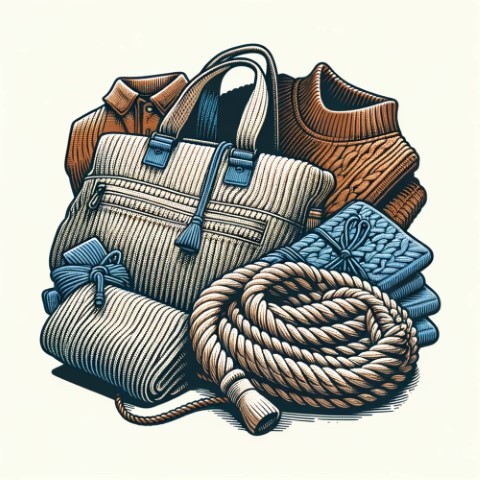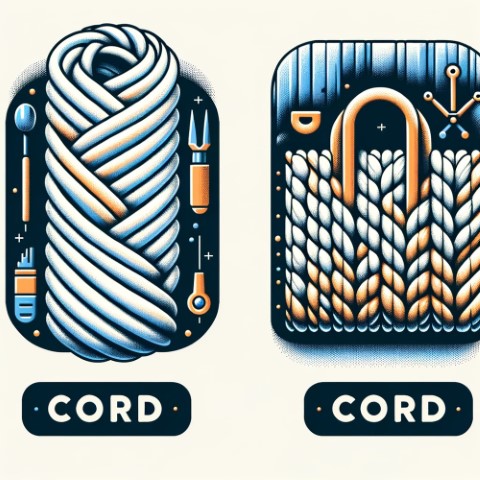Last Updated on: 26-Apr-2024 ( ago)
Share on Facebook • Share on Twitter
Cord Chronicles: Unveiling the Secrets of Textile Evolution
The Fabric of History: Unraveling the Mystique of Cord
Welcome, textile enthusiasts, to a journey through the captivating world of cord. Cord, with its intricate weave and rich history, is more than just a fabric it's a testament to human ingenuity and creativity. Picture the ancient looms, diligently crafting strands of yarn into sturdy cords, weaving tales of craftsmanship and innovation that span centuries.
Cord has a fascinating role in the tapestry of textiles, dating back to ancient civilizations where it adorned the attire of royalty and commoners alike. Its versatility knows no bounds, as it has been used in everything from sturdy workwear to luxurious evening gowns, offering durability and elegance in equal measure.
But cord is more than just a fabric; it's a symbol of resilience and strength. Its tightly woven structure provides support and structure, making it an essential component in the creation of durable garments and accessories. As we unravel the threads of history, we discover the enduring allure of cord and its timeless relevance in the ever-evolving world of fashion and textiles.
Profiles of Major Manufacturers and Users of Cord in Textiles
- 1. Cordura - Invista
Cordura fabric, developed by Invista, is renowned for its exceptional durability and versatility. Used in a wide range of applications, from military gear to outdoor equipment and fashion accessories, Cordura sets the standard for performance textiles. With a legacy spanning decades, Invista continues to innovate and push the boundaries of textile engineering, ensuring Cordura remains a preferred choice for manufacturers and users seeking high-quality, long-lasting fabrics.
- 2. Patagonia
Patagonia, a leading outdoor apparel brand, utilizes cord fabrics in many of its products, including jackets, backpacks, and tents. Known for its commitment to sustainability and ethical manufacturing practices, Patagonia sources cord materials responsibly, ensuring minimal environmental impact throughout the production process. By incorporating durable and eco-friendly cord fabrics into its designs, Patagonia continues to deliver performance-driven outdoor gear while advocating for environmental stewardship.
- 3. E. I. du Pont de Nemours and Company (DuPont)
DuPont, a multinational chemical company, is a key player in the production of high-performance textiles, including cord fabrics. Leveraging advanced manufacturing technologies and innovative materials, DuPont produces cords that offer superior strength, abrasion resistance, and longevity. These qualities make DuPont's cord fabrics ideal for applications ranging from automotive upholstery to industrial equipment, where durability and reliability are paramount.
- 4. The North Face
The North Face, a renowned outdoor clothing and equipment company, integrates cord fabrics into its product lines to enhance durability and performance. Whether it's backpacks, tents, or outerwear, The North Face prioritizes quality and functionality, making cord materials an integral part of its design philosophy. With a focus on innovation and customer satisfaction, The North Face continues to push the boundaries of outdoor gear, relying on cord fabrics to withstand the rigors of exploration and adventure.
- 5. Gore-Tex - W. L. Gore & Associates
Gore-Tex, developed by W. L. Gore & Associates, is a waterproof and breathable fabric commonly used in outdoor apparel and equipment. Cord fabrics are often incorporated into Gore-Tex products to enhance strength and durability, ensuring optimal performance in extreme conditions. With a reputation for quality and reliability, Gore-Tex remains a trusted choice among outdoor enthusiasts and professionals worldwide, solidifying W. L. Gore & Associates' position as a leader in technical textiles.
Exploring the Versatility: Applications of Cord in Textiles
- 1. Outdoor Apparel:
Cord fabrics are extensively used in outdoor apparel such as jackets, pants, and vests. The durable and abrasion-resistant nature of cord materials makes them ideal for rugged outdoor activities. Whether hiking, camping, or mountaineering, garments made with cord fabrics offer exceptional durability and protection against the elements, ensuring comfort and reliability in challenging environments.
- 2. Upholstery:
Cord fabrics find application in upholstery for furniture, automotive interiors, and decorative accessories. The textured surface and robust construction of cord materials add visual interest and enhance the longevity of upholstered items. Whether used in sofas, car seats, or throw pillows, cord fabrics contribute to the aesthetic appeal and durability of interior spaces.
- 3. Accessories:
Cord fabrics are utilized in various accessories such as bags, backpacks, and hats. The strength and resilience of cord materials make them suitable for carrying heavy loads and enduring frequent use. From stylish backpacks to durable tote bags, accessories made with cord fabrics combine fashion and functionality, catering to the needs of modern consumers.
- 4. Industrial Applications:
Cord fabrics play a crucial role in industrial applications such as conveyor belts, safety harnesses, and industrial curtains. The robust construction and high tensile strength of cord materials make them well-suited for heavy-duty tasks in manufacturing and logistics. Whether transporting goods or ensuring worker safety, cord fabrics contribute to the efficiency and reliability of industrial operations.
- 5. Sports Equipment:
Cord fabrics are incorporated into various sports equipment, including backpacks, tents, and athletic apparel. The lightweight yet durable properties of cord materials make them ideal for sports gear that requires flexibility and resilience. Whether on the trail, at the gym, or on the field, sports equipment made with cord fabrics enhances performance and endurance, enabling athletes to pursue their passions with confidence.
The Fabric of Time: A Brief History of Cord in Textiles
Cord, derived from the Latin word "chorda," has been an integral part of textile production for centuries. Dating back to ancient civilizations, cord was traditionally made from natural fibers such as cotton, hemp, or wool, spun into sturdy threads and woven into various fabrics. Over time, advancements in textile technology have led to the development of synthetic cord materials, offering enhanced strength, durability, and versatility.
- Natural Cord:
Natural cord is made from organic fibers such as cotton, hemp, or wool. It is prized for its softness, breathability, and eco-friendly properties, making it ideal for clothing, upholstery, and crafts.
- Synthetic Cord:
Synthetic cord is manufactured from man-made materials such as nylon, polyester, or polypropylene. It offers superior strength, abrasion resistance, and colorfastness, making it suitable for outdoor gear, industrial applications, and sports equipment.
- Elastic Cord:
Elastic cord, also known as bungee cord or shock cord, contains elastic fibers that allow it to stretch and retract. It is commonly used in luggage straps, outdoor gear, and medical devices where flexibility and resilience are required.
- Leather Cord:
Leather cord is crafted from animal hides and is valued for its natural texture, durability, and luxurious appearance. It is often used in jewelry making, fashion accessories, and leathercraft projects.
- Reflective Cord:
Reflective cord is woven with reflective fibers or coated with reflective material, providing visibility in low-light conditions. It is commonly used in safety gear, outdoor equipment, and accessories for nighttime visibility.
Tips for Handling Cord in Textiles
- Store Properly:
Store cord in a cool, dry place away from direct sunlight to prevent fading and deterioration of the fibers.
- Handle with Care:
Avoid excessive pulling or twisting of cord fabrics to prevent stretching or damage to the fibers.
- Clean Gently:
When cleaning cord textiles, use mild detergent and lukewarm water to preserve the integrity of the fibers.
- Avoid Friction:
Minimize friction between cord fabrics and rough surfaces to prevent pilling or abrasion of the fibers.
- Test Before Use:
Before using cord materials for sewing or crafting projects, conduct a test wash or stretch to ensure compatibility with the intended application.
Conclusion: Unraveling the Impact of Cord in Textiles
In conclusion, the journey through the realm of cord in textiles has revealed its profound impact on the industry. From its humble origins in natural fibers to the diverse array of synthetic and decorative varieties available today, cord fabrics have played a pivotal role in shaping the fabric landscape.
The versatility and durability of cord fabrics make them indispensable in various applications, from outdoor apparel and upholstery to industrial settings and sports equipment. Their strength and resilience ensure longevity and performance, making them a preferred choice for manufacturers and consumers alike.
As we navigate the ever-evolving textile industry, the importance of understanding and appreciating the significance of cord fabrics cannot be overstated. From their historical significance to their practical utility, cord fabrics continue to leave an indelible mark on the fabric of our lives.
Moving forward, it is imperative for researchers, designers, and industry professionals to continue exploring the potential of cord fabrics, pushing the boundaries of innovation and sustainability. By harnessing the unique properties of cord fabrics and embracing new technologies, we can unlock new possibilities and pave the way for a brighter future in textiles.
Cords consist of plied yarns (plies) that have been twisted together. When used for a seam a tape is sewn onto the edge of the cord. Cords are frequently used in place of fabric welting.
�Cord is twisted fibre, usually intermediate between rope and string. It is also used as a shortened form of corduroy.
�Strands of nylon, rayon, polyester, steel or fiberglass that make up the plies & belts of the tire. The strength of a tire & its load carrying capacity is determined by the strength of the cords.
�A term used to describe the way in which textile strands have been twisted, such as in cabled or plied yarns.
Some other terms
Some more terms:
On this page
Add a definition
- The term you want to define
- Its definition in 500 words or less
- Attach an image if necessary.
- Optionally, tell us about yourself in 200 words or less!
Companies for Cord:
- Company name
- Company address
- Attach a logo, if necessary.
- Optionally, tell us about yourself in 200 words or less!

